Four-buckle boots are viewed by many backcountry skiers as the minimum required touring boot for hard-charging downhill turns. While I can’t say I agree with this characterization (my Spirit 3’s were plenty of boot), at 1,510 grams Scarpa Maestrale will be the lightest 4-buckle boot made when it comes out next fall. Thus, we can have one more buckle with no weight penalty, so why not?
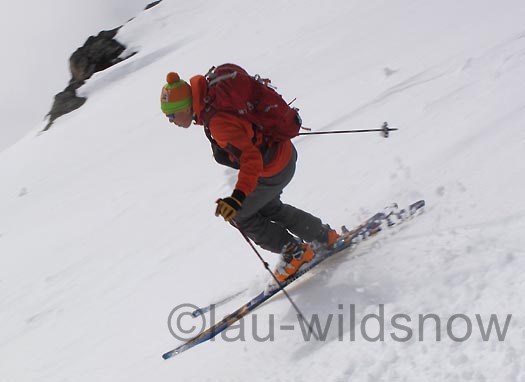
Lee testing the Maestrale backcountry skiing boot.
My test Maestrales weighed a total of 1510g per boot (Scarpa claims 1516g). The included liner is basically Intuition’s Pro-Tour liner without laces and weighs 220g – you really can’t get much lighter than that. The shells weigh 1290g). To compare against other 4-buckle boots, my old soldier Garmont Megarides weigh 1640g per boot while my Dynafit ZZeus boot (both boots have Intuitions) are 1780g. Other boot weights.
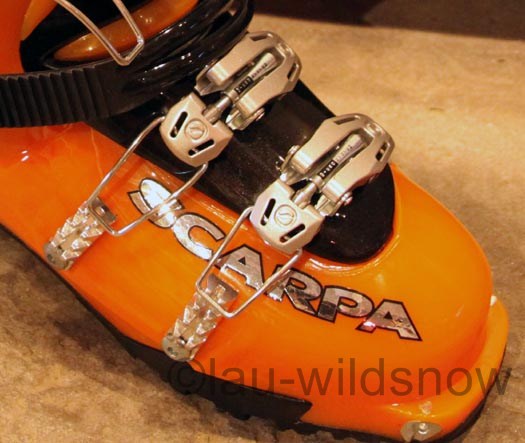
Closeup of Maestrale front toebox shows the Dynafit brand easy-step in tech fittings & removable-with-tools magnesium buckles.
Scarpa achieved weight savings with Maestrale with astounding attention to detail. For example:
* Scarpa shaved plastic in the forefoot and heel but designed in raised areas/ribs in those same areas to keep the boot stiff yet light.
* Buckles and a lot of the mounting hardware are magnesium.
* A waterproof/breathable mesh material covers part of the heel.
* Sole material was also shaved from the side to save weight. Scarpa’s experience was that most wear was at the heel and toe and this was left untouched
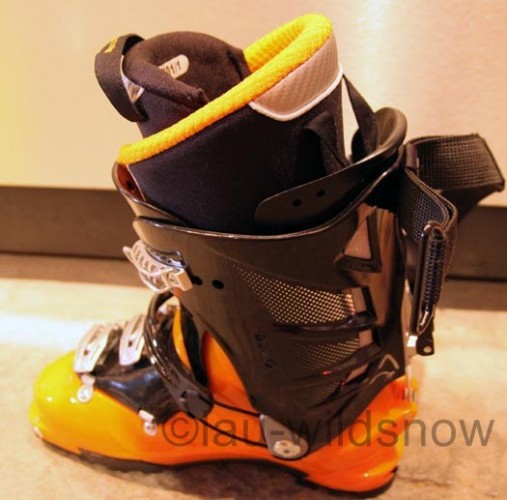
Rear shot of the Maestrale shows the stiffening black plastic ribs & the water-breathable material.
Fit and technical details
I have a traditional Asian foot; which means that my forefoot is wider then most and I don’t have any arch to speak of. The Maestrale has a new mold and has a bit less forefoot volume than the Spirit 4 and 3 (I have asked for a last size measurement from Scarpa). I fit a 27.0 Mastreale very well with the stock liner once it was cooked (the liner was thermo-molded in an Intuition-supplied blower-style oven). Unlike the Skookum, Spirit 4 and 3 where I had to cinch forefoot buckles very tight to get a good fit, I only had to moderately tighten Maestrale buckles to obtain good downhill ski performance.
The new tongue design is the most readily apparent departure from previous Scarpas. The hinged tongue is said to make entry and exit easier (a boon in overnight trips). The tongue is also a partial overlap (its held on with clips on one side) so it distributes downhill ski forces accordingly and gives the user a bit more volume adjustment.
More technical tidbits:
* Scarpa continues a laudable tradition of user-serviceable & removable buckles & mounting hardware.
* Licensed Dynafit quick-step tech fittings.
* In tour mode the boot can recline to minus 15 degrees from vertical.
* Two ski modes: 18 & 22 degrees.
* There is a hinge on the top buckle to assist in keeping it in place while transitioning from ski to tour mode
* No removable bootboard (reduces ability to customize but saves weight).
* Instead of a velcro power strap included is Scarpa’s “dynamic power strap” which is wider, has neoprene but is lighter than a Booster strap (as it replaces the metal cam with velcro).
* Interior rivets are recessed so they no longer abrade the liner.
* Cuff has a cant rivet.
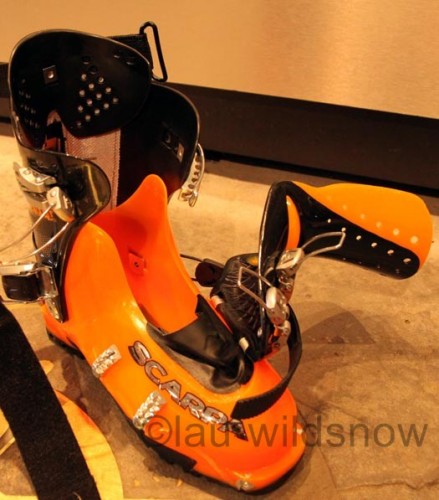
Maestrale tongue flips opens to the side to facilitate getting in and out (useful for cold weather).
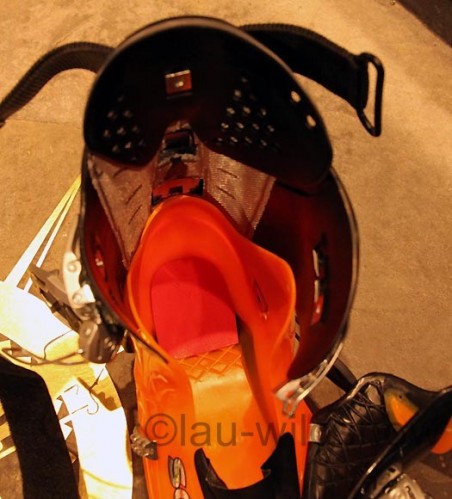
Maestrale interior. Note the recessed interior rivets--nice attention to detail.
On Snow Performance – Skiing
I put Maestrale in the 18 degree lean mode while skiing. I would rate Maestrale’s stiffness as comparable to the Spirit 4 with its stock touring tongue; perhaps slightly stiffer. Fore & aft and laterally it is reasonably stiff. The boot is definitely noticeably stiffer than my Megarides and my old Spirit 3s (yet quite a bit lighter). Even so, this boot is certainly not in the same category as my stiffer Dynafit ZZeus boots or the stiffest-in-class four-buckle Dynafit Titans.
If there is anything mildly negative about the Maestrales, it might be that it doesn’t quite ski like an overlap boot and has that same slight harshness of power transmission characteristic of tongue boots. Also, while indeed plenty of boot, and I found it to be a step below the beef you need to rail groomers.
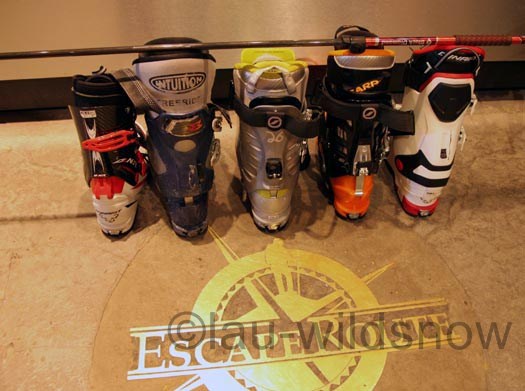
Comparison of rear cuff heights (from L to R: Dynafit DNA, Garmont Megaride, Scarpa Shaka, Maestrale and Dynafit Titan. The ruler is held level on the Titan's liner. The tallest boot shell is the Titan followed closely by the Shaka and Maestrale.
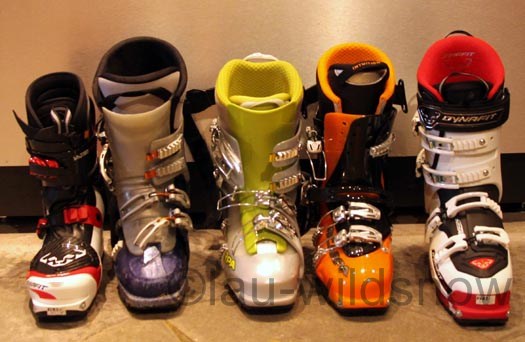
Comparison of fronts of all boots show that they are all very comparable except for Dynafit DNA.
On Snow Performance – touring
I used my own Intuition Protour liners when testing the Maestrale while touring (Scarpa OE liners are identical in design). This is, by far, the best four-buckle touring boot I have ever had the pleasure of putting on my feet. That is perhaps unsurprising, as everything about Maestrale is functionally designed to make it state-of-art: incredible range of fore-aft motion, free-floating cuff, superior Intuition liner, lack of mass.
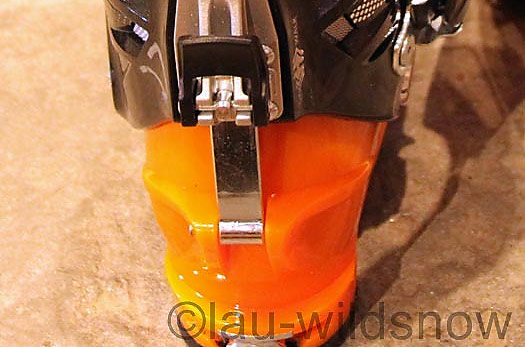
Maestrale walk ski mode switch.
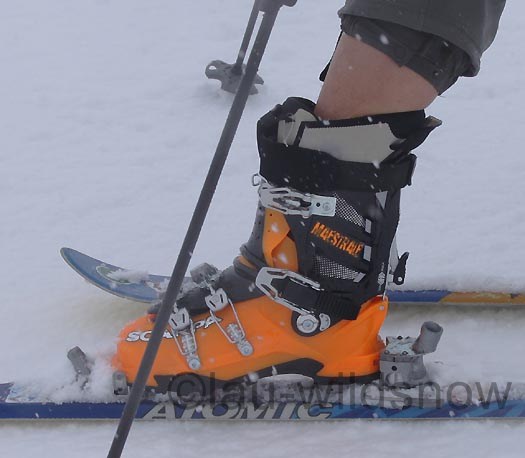
Maestrale has a best in class free-floating cuff among four-buckle boots--a barcalounger minus 15 degrees!
Summary
In my opinion Maestrale is now the clear leader in the light-weight four buckle boot category. The boot will be shipped in a size range of size: 24.5 – 31. Reversing an ugly trend of rising prices, the MSRP of Maestrale is USD $ 599. Available next fall or early winter.
Author’s Bias
I weigh 160 lbs and ski mainly in the Coast Mountains of British Columbia in the Vancouver/Whistler/Squamish area. I often travel to the Selkirks, the Monashees and to other touring destinations in B.C. However, my skiing is usually in fairly high moisture-content snow. Accordingly, my preference is for bigger skis and boots. I ski about a 100 days a season. About 70% of my skiing involves some touring. I’ve used a variety of boots, and if you have a question about the Maestrales and want a comparison to other boots please leave questions in the comments section below.
Review of the Scarpa Maestrale alpine touring boot from Lee Lau on Vimeo.
(Guest blogger Lee Lau is an avid skier and outdoorsman embarking on many adventures with his loving, and sometimes concerned wife, Sharon. He has over fifteen years of experience backcountry skiing and dabbles in mountaineering. In the “off-season” he is occasionally found working in his day job as an intellectual property lawyer when he is not mountain biking. As a resident of Vancouver and Whistler, British Columbia, Lee’s playground extends mainly to Western Canada, including South West B.C. and the Selkirks.)
Guest blogger Lee Lau is an avid skier and outdoorsman embarking on many adventures with his loving, and sometimes concerned wife, Sharon. He has over 15 years of experience skiing, ski-touring and dabbles in mountaineering. In the “off-season” he is occasionally found working in his day job as an intellectual property lawyer when he is not mountain biking. As a resident of Vancouver, British Columbia, Lee’s playground extends mainly to Western Canada, including South West B.C. and the Selkirks.
